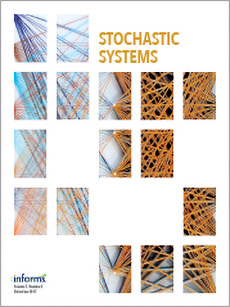Abstract
We study an ordinary differential equation (ODE) arising as the many-server heavy-traffic fluid limit of a sequence of overloaded Markovian queueing models with two customer classes and two service pools. The system, known as the $X$ model in the call-center literature, operates under the fixed-queue-ratio-with-thresholds (FQR-T) control, which we proposed in a recent paper as a way for one service system to help another in face of an unanticipated overload. Each pool serves only its own class until a threshold is exceeded; then one-way sharing is activated with all customer-server assignments then driving the two queues toward a fixed ratio. For large systems, that fixed ratio is achieved approximately. The ODE describes system performance during an overload. The control is driven by a queue-difference stochastic process, which operates in a faster time scale than the queueing processes themselves, thus achieving a time-dependent steady state instantaneously in the limit. As a result, for the ODE, the driving process is replaced by its long-run average behavior at each instant of time; i.e., the ODE involves a heavy-traffic averaging principle (AP).
Citation
Ohad Perry. Ward Whitt. "An ODE for an overloaded X model involving a stochastic averaging principle." Stoch. Syst. 1 (1) 59 - 108, 2011. https://doi.org/10.1214/10-SSY009
Information





